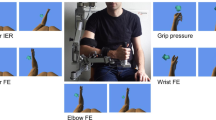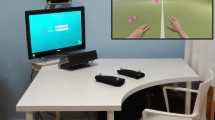Abstract
For an optimal guidance of the rehabilitation therapy of stroke patients in an in-home setting, objective, and patient-specific performance assessment of arm movements is needed. In this study, metrics of hand movement relative to the pelvis and the sternum were estimated in 13 stroke subjects using a full body ambulatory movement analysis system, including 17 inertial sensors integrated in a body-worn suit. Results were compared with the level of arm impairment evaluated with the upper extremity part of the Fugl-Meyer Assessment scale (uFMA). Metrics of arm movement performance of the affected side, including size of work area, maximum reaching distance and movement range in vertical direction, were evaluated during a simulated daily-life task. These metrics appeared to strongly correlate with uFMA scores. Using this body-worn sensor system, metrics of the performance of arm movements can easily be measured and evaluated while the subject is ambulating in a simulated daily-life setting. Suggested metrics can be used to objectively assess the performance of the arm movements over a longer period in a daily-life setting. Further development of the body-worn sensing system is needed before it can be unobtrusively used in a daily-life setting.



Similar content being viewed by others
Abbreviations
- uFMA:
-
Upper extremity part of the Fugl-Meyer assessment scale (0–66 points)
- IMU:
-
Inertial measurement unit
References
Bergmann, J. H. M., and A. H. McGregor. Body-worn sensor design: what do patients and clinicians want? Ann. Biomed. Eng. 39:2299–2312, 2011.
Bussmann, J. B. J., W. L. J. Martens, J. H. M. Tulen, F. C. Schasfoort, H. J. G. Van Den Berg-Emons, and H. J. Stam. Measuring daily behavior using ambulatory accelerometry: the Activity Monitor. Behav. Res. Methods. Instrum. Comput. 33:349–356, 2001.
Cirstea, M. C., and L. F. Mindy. Compensatory strategies for reaching in stroke. Brain 123:940–953, 2000.
de los Reyes-Guzmán, A., I. Dimbwadyo-Terrer, F. Trincado-Alonso, F. Monasterio-Huelin, D. Torricelli, and A. Gil-Agudo. Quantitative assessment based on kinematic measures of functional impairments during upper extremity movements: a review. Clin. Biomech. 29:719–727, 2014.
Dewald, J. P. A., V. Sheshadri, M. L. Dawson, and R. F. Beer. Upper-limb discoordination in hemiparetic stroke: implications for neurorehabilitation. Top Stroke Rehabil. 8:1–12, 2001.
Dipietro, L., H. I. Krebs, S. E. Fasoli, B. T. Volpe, J. Stein, C. Bever, and N. Hogan. Changing motor synergies in chronic stroke. J. Neurophysiol. 98:757–768, 2007.
Ellis, M. D., T. Sukal, T. DeMott, and J. P. A. Dewald. Augmenting clinical evaluation of hemiparetic arm movement with a laboratory-based quantitative measurement of kinematics as a function of limb loading. Neurorehabil. Neural Repair 22:321–329, 2008.
Ellis, M. D., T. Sukal-Moulton, and J. P. A. Dewald. Progressive shoulder abduction loading is a crucial element of arm rehabilitation in chronic stroke. Neurorehabil. Neural Repair 23:862–869, 2009.
Fugl-Meyer, A. R., L. Jääskö, I. Leyman, S. Olsson, and S. Steglind. The post-stroke hemiplegic patient. 1. A method for evaluation of physical performance. Scand. J. Rehabil. Med. 7:13–31, 1975.
Geyh, S., A. Cieza, J. Schouten, H. Dickson, P. Frommelt, Z. Omar, N. Kostanjsek, H. Ring, and G. Stucki. ICF Core Sets for stroke. J. Rehabil. Med. 36:135–141, 2004.
Giansanti, D., V. Macellari, G. Maccioni, and V. Macellari. The development and test of a device for the reconstruction of 3-D position and orientation by means of a kinematic sensor assembly with rate gyroscopes and accelerometers. IEEE Trans. Biomed. Eng. 52:1271–1277, 2005.
Kamper, D. G., A. N. McKenna-Cole, L. E. Kahn, and D. J. Reinkensmeyer. Alterations in reaching after stroke and their relation to movement direction and impairment severity. Arch. Phys. Med. Rehabil. 83:702–707, 2002.
Kollen, B., G. Kwakkel, and E. Lindeman. Functional recovery after stroke: a review of current developments in stroke rehabilitation research. Rev. Recent. Clin. Trials. 1:75–80, 2006.
Krabben, T., B. I. Molier, A. Houwink, J. S. Rietman, J. H. Buurke, and G. B. Prange. Circle drawing as evaluative movement task in stroke rehabilitation: an explorative study. J. Neuroeng. Rehabil. 8:15, 2011.
Lorussi, F., S. Galatolo, R. Bartalesi, and D. De Rossi. Modeling and characterization of extensible wearable textile-based electrogoniometers. IEEE Sens. J. 13:217–228, 2013.
Luinge, H. J., and P. H. Veltink. Measuring orientation of human body segments using miniature gyroscopes and accelerometers. Med. Biol. Eng. Comput. 43:273–282, 2005.
Lyle, R. C. A performance test for assessment of upper limb function in physical rehabilitation treatment and research. Int. J. Rehabil. Res. 4:483–492, 1981.
Merdler, T., D. G. Liebermann, M. F. Levin, and S. Berman. Arm-plane representation of shoulder compensation during pointing movements in patients with stroke. J. Electromyogr. Kinesiol. 23:938–947, 2013.
Murphy, M. A., C. Willén, and K. S. Sunnerhagen. Kinematic variables quantifying upper-extremity performance after stroke during reaching and drinking from a glass. Neurorehabil. Neural. Repair. 25:71–80, 2011.
Pérez, R., Ú. Costa, M. Torrent, J. Solana, E. Opisso, C. Cáceres, J. M. Tormos, J. Medina, and E. J. Gómez. Upper limb portable motion analysis system based on inertial technology for neurorehabilitation purposes. Sensors 10:10733–10751, 2010.
Roetenberg, D., P. J. Slycke, and P. H. Veltink. Ambulatory position and orientation tracking fusing magnetic and inertial sensing. IEEE Trans. Biomed. Eng. 54:883–890, 2007.
Roetenberg, D., H. Luinge, and P. Slycke. Xsens MVN: full 6DOF Human Motion Tracking Using Miniature Inertial Sensors. Xsens Motion Technologies BV, Technical Report,s 2009.
Roorda, L. D., A. Houwink, W. Smits, I. W. Molenaar, and A. C. Geurts. Measuring upper limb capacity in post stroke patients: development, fit of the monotone homogeneity model, unidimensionality, fit of the double monotonicity model, differential item functioning, internal consistency, and feasibility of the stroke upper limb capacity scale, SULCS. Arch. Phys. Med. Rehabil. 92:214–227, 2011.
Subramanian, S. K., J. Yamanaka, G. Chilingaryan, and M. F. Levin. Validity of movement pattern kinematics as measures of arm motor impairment poststroke. Stroke 41:2303–2308, 2010.
Sunderland, A., D. J. Tinson, E. L. Bradley, D. F. Hewer, and D. T. Wade. Enhanced physical therapy improves recovery of arm function after stroke: a randomized controlled trial. J. Neurol. Neurosurg. Psychiatr. 55:530–535, 1992.
Thies, S. B., P. A. Tresadern, L. P. Kenney, J. Smith, D. Howard, J. Y. Goulermas, C. Smith, and J. Rigby. Movement variability in stroke patients and controls performing two upper limb functional tasks: a new assessment methodology. J. Neuroeng. Rehabil. 6:1–12, 2009.
Uswatte, G., W. L. Foo, H. Olmstead, K. Lopez, A. Holand, and L. B. Simms. Ambulatory monitoring of arm movement using accelerometry: an objective measure of upper-extremity rehabilitation in persons with chronic stroke. Arch. Phys. Med. Rehabil. 86:1498–1501, 2005.
van Dokkum, L., I. Hauret, D. Mottet, J. Froger, J. Métrot, and I. Laffont. The contribution of kinematics in the assessment of upper limb motor recovery early after stroke. Neurorehabil. Neural Repair 28:4–12, 2014.
Veltink, P. H., F. B. van Meulen, B. J. F. van Beijnum, B. Klaassen, H. J. Hermens, E. Droog, M. Weusthof, F. Lorussi, A. Tognetti, J. Reenalda, C. D. M. Nikamp, C. Baten, J. H. Buurke, J. Held, A. Luft, H. Luinge, G. De Toma, C. Mancusso, R. Paradiso. Daily-life tele-monitoring of motor performance in stroke survivors. 13th International Symposium on 3D Analysis of Human Movement, 3D-AHM 2014, 14-17 July 2014, Lausanne, Switzerland. Extended abstract pp. 159–162, 2014.
Wagner, J. M., J. A. Rhodes, and C. Patten. Reproducibility and minimal detectable change of three-dimensional kinematic analysis of reaching tasks in people with hemiparesis after stroke. Phys. Therapy 88:652–663, 2008.
Zheng, H., N. D. Black, and N. D. Harris. Position-sensing technologies for movement analysis in stroke rehabilitation. Med. Biol. Eng. Comput. 43:413–420, 2005.
Acknowledgments
The authors would like to thank Dirk Weenk for his assistance in data collection of this study and all participants of the clinical trial. This study is part of the INTERACTION project, which is partially funded by the European Commission under the 7th Framework Programme (FP7-ICT-2011-7-287351).
Author information
Authors and Affiliations
Corresponding author
Additional information
Associate Editor Amit Gefen oversaw the review of this article.
Rights and permissions
About this article
Cite this article
van Meulen, F.B., Reenalda, J., Buurke, J.H. et al. Assessment of Daily-Life Reaching Performance After Stroke. Ann Biomed Eng 43, 478–486 (2015). https://doi.org/10.1007/s10439-014-1198-y
Received:
Accepted:
Published:
Issue Date:
DOI: https://doi.org/10.1007/s10439-014-1198-y




